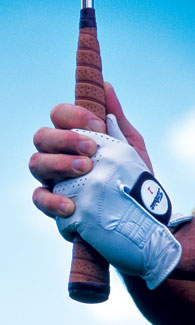The putting grip best represents the individuality of golf. On Tour, if there are 160 golfers playing in an event, you’ll find no less than 160 different putting grips.

Yet there are common elements to good putting grips that enable the golfer to consistently strike the ball in the center of the putterface. One of these elements is gripping the putter with the palms, rather than the fingers. If you grip your putter mostly with your fingers, you’ll give your wrists too much freedom to hinge and unhinge.
In putting, control and consistency are the keys. Gripping the club in your palms effectively takes your wrists out of play. As a result, your putterface will tend to stay on line and contact the ball consistently in the sweet spot.
If your current grip places too much of the handle in your fingers, you’ll need to adjust it so more of the grip fits in your palms. Furthermore, you should make a second alteration to ensure that your hands function as a single unit. Try this: After placing your hands on the putter’s handle, slide the lower hand up until the pinkie, forefinger and middle finger rest atop your lead hand. This triple overlap grip effectively quiets the movement of the dominant hand (the right hand for right-handed golfers) during the putting stroke. A less-active dominant side will translate into better grip pressure and keep the hands working together, a key requirement to keeping the putterhead moving along the target line.
Place the grip in your palms, not your fingers, to help prevent tension, and position your thumbs on top of the grip for better feel and control.